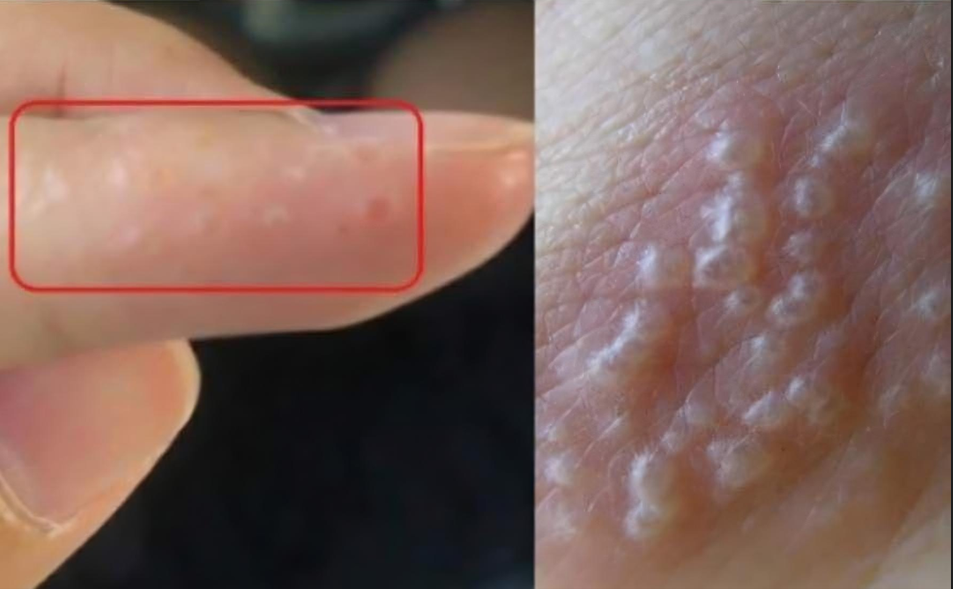Living with skin conditions can be challenging, especially when they interfere with your daily life and enjoyment of the seasons. Dyshidrotic eczema, often called “foot-and-hand eczema,” is one such condition that presents as painful, itchy red bumps or blisters on the palms, soles, and sides of fingers and toes. While the condition may seem minor at first, its symptoms can significantly impact comfort and confidence.
Let’s explore what causes dyshidrotic eczema, how to identify it, and most importantly, how to manage it effectively.

What Is Dyshidrotic Eczema?
Dyshidrotic eczema is a chronic skin condition characterized by small, itchy blisters. These blisters often appear in clusters and can cause intense discomfort, particularly during flare-ups. This form of eczema typically affects the hands and feet, making everyday activities like walking, writing, or handling objects painful and frustrating.
The blisters associated with dyshidrotic eczema can last for several weeks, eventually drying out and peeling, leaving behind cracked or sensitive skin. This cycle can repeat, especially if the underlying triggers aren’t addressed.
Recognizing the Symptoms of Dyshidrotic Eczema
The condition manifests in several telltale signs that differentiate it from other forms of eczema. Here’s what to watch for:
- Small Blisters: These are often filled with clear fluid and appear on the fingers, palms, soles, or sides of the toes.
- Intense Itching: The blisters can itch severely, leading to discomfort and potential scratching, which can worsen the condition.
- Red, Inflamed Skin: The affected areas may appear red and swollen, especially during active flare-ups.
- Cracked or Peeling Skin: As the blisters heal, the skin may crack or peel, leaving it vulnerable to infections.
- Burning Sensation: Some individuals report a burning or stinging feeling in the affected areas.
What Causes Dyshidrotic Eczema?
While the exact causes of dyshidrotic eczema remain unclear, experts believe it stems from an overactive immune response to various triggers. Common culprits include:
- Allergens: Seasonal pollen, pet dander, or other environmental allergens can provoke a flare-up.
- Stress and Anxiety: Emotional stress is a known trigger for many skin conditions, including dyshidrotic eczema.
- Irritants: Harsh soaps, detergents, or exposure to chemicals can aggravate the skin.
- Weather Conditions: Sweating, humidity, and warmer weather can exacerbate symptoms.
- Underlying Skin Sensitivities: Individuals with a history of eczema, allergies, or asthma are more prone to developing dyshidrotic eczema.
Understanding your unique triggers is crucial for preventing future flare-ups and minimizing discomfort.
Effective Treatments for Dyshidrotic Eczema
Although there’s no cure for dyshidrotic eczema, it can be managed successfully with a combination of medical treatments, home remedies, and lifestyle adjustments.
Medical Treatments
- Topical Corticosteroids: These are often prescribed to reduce inflammation and itching.
- Oral Antihistamines: These can alleviate itching, especially at night.
- Immunosuppressant Creams: Medications like tacrolimus (Protopic) or pimecrolimus (Elidel) help calm the immune system’s overactivity.
- Phototherapy: In severe cases, light therapy may be recommended to reduce symptoms.
Natural Remedies
- Cold Compresses: Apply a cold compress to the affected area for immediate relief from itching and inflammation.
- Aloe Vera: Known for its soothing properties, aloe vera gel can promote healing and hydration.
- Oatmeal Baths: Colloidal oatmeal can calm irritated skin and reduce dryness.
Lifestyle Changes
- Identify and Avoid Triggers: Whether it’s a specific soap or a stressful situation, understanding and avoiding triggers is essential.
- Moisturize Regularly: Use fragrance-free, hypoallergenic moisturizers to keep your skin hydrated and protected.
- Practice Stress Management: Techniques like yoga, meditation, or journaling can reduce flare-ups caused by stress.
Protecting Your Skin During Flare-Ups
Managing dyshidrotic eczema goes beyond treating the symptoms—it’s also about preventing them. During flare-ups or when conditions are ripe for irritation, take extra precautions to protect your skin.
Sun Exposure
- Use a broad-spectrum sunscreen with SPF 30 or higher to shield your skin.
- Opt for lightweight, breathable fabrics and seek shade whenever possible.
Swimming and Water Activities
- Rinse your skin with fresh water immediately after swimming in chlorinated or saltwater.
- Follow up with a generous application of fragrance-free moisturizer.
Sweating and Humidity
- Wear moisture-wicking clothing to keep sweat at bay.
- Keep affected areas clean and dry to prevent additional irritation or infection.
Living with Dyshidrotic Eczema: Embrace a Carefree Summer
The warm months don’t have to be a time of discomfort and worry. By implementing an effective management strategy, you can enjoy the season to its fullest. Stay proactive with regular skincare, avoid known triggers, and consult a dermatologist if symptoms worsen.
Millions of people live with dyshidrotic eczema, and while it can be challenging, it doesn’t have to define your life. With the right tools, knowledge, and support, you can minimize flare-ups and focus on the moments that matter most.
Conclusion: Take Charge of Your Skin Health
Dyshidrotic eczema may present its fair share of obstacles, but it’s manageable with the right approach. From understanding your triggers to incorporating effective treatments and lifestyle changes, every step you take brings you closer to relief.
So, whether it’s enjoying a sunny day at the beach or tackling your daily routine with confidence, don’t let dyshidrotic eczema hold you back. Embrace the challenge, stay proactive, and let your resilience shine through—because you deserve to live life without limits.